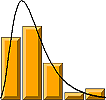Interactive publication
This interactive web publication will guide you through an entire process of data analysis on time series of persistent organic pollutants (POPs) carried out in a framework of the GENASIS project. The analysis consists of eight steps - from visual inspection of the data to obtaining the final results of descriptive statistics and trend tests. Each step is supplemented by an interactive example, where all the methods, R source code and several descriptions, comments and notes are available for hands-on training and practice.
|
R source code
Each of the eight consequent steps of the data analysis is equipped with an R source code, which is partially compatible with the interactive example for the particular step. Most of the source codes use functions and methods from the R package genasis, developped in order to simplify and unify POPs data processing. This package shares several methods with the Global Monitoring Plan (GMP) methodology on POPs monitoring data processing. The genasis R package is freely available on CRAN repository web page.
|
Interactive examples
Demonstrative interactive examples were developed in order to allow the user trying all the described methods on his/her own in a real time. They are very intuitive and easy to manage even without any knowledge of R or another statistical software. All the examples include plots to emonstrate how the functions work and a brief legend on the methods used. The examples are accesible via the square tiles below the text.
The Shiny R package was used to create all the examples.
|
Authors
Jiří Kalina, Jiří Jarkovský, Ladislav Dušek, Jana Klánová, Jana Borůvková, Ivo Šnábl and Roman Šmíd
Institute of Biostatisic and analyses &
Research Centre for Toxic Compounds in the Environment
Masaryk University
Kamenice 126/3
625 00 Brno
Czech Republic
kalina@iba.muni.cz
|

